In my opinion, no matter how strong your customer retention rate is, it’s also important to know how satisfied customers are with your business. Using surveys to collect customer feedback ensures you’re up to date on the needs of your target audience, and a Likert scale is an effective type of question scale to use.
In this post, I’ll discuss what a Likert scale is and how you can use it to optimize your surveys. Then, I’ll provide some examples and templates you can use for your feedback collection process.
Table of Contents
- What Is a Likert Scale?
- Likert Scale Questions
- Likert Scale Example Question Types
- How to Read Likert Scale Results
- Tips for Writing Likert Scale Survey Questions
- Likert Scale Templates
What Is a Likert Scale?
A Likert scale is a closed-ended survey question that measures a participant's opinions on a series of statements. Participants consider the prompt and then choose from a selection of answers that range from opposite extremities. Likert scales can have five, seven, or nine points, depending on the level of depth required from participants.
The scale is named after Rensis Likert, who developed the method in 1932 to gauge people’s opinions on or attitudes toward a topic.
The two responses on either extreme are the anchor responses and go from negative to positive, with the middle term being neutral. This is the case whether you choose to have 5, 7, or 9 response choices.

When to Use a Likert Scale
When might you use a Likert scale? If you want to do any of the following:
- Measure attitudes. Likert scales help capture participant sentiment when you want to assess respondents’ feelings, opinions, or attitudes toward a particular statement, product, or concept.
- Capture nuanced responses. When simple binary choices are insufficient, Likert scales allow for varying degrees of agreement or disagreement.
- Compare multiple statements. If you have several statements related to a single topic and want to analyze differences in responses, a Likert scale makes it easy to compare them.
- Survey research. In surveys where you want to gather quantitative data on subjective topics, such as customer satisfaction, employee engagement, or public opinion.
- Test changes over time. When conducting longitudinal studies, Likert scales can help track changes in attitudes or perceptions over time.
- Quantify qualitative feedback. If you want to quantify qualitative insights from open-ended responses, converting them into Likert-style questions can provide measurable data.
Likert Scale Questions
Likert scale questions create consistency when surveying participants on qualitative topics. Rather than letting the participant describe their own experience, they're provided with predefined options to measure it. That way, surveyors can obtain specific feedback using a quantified response.
For example, if you wanted to know how much customers like your logo, you could say, “On a scale of 1 to 5, please rate how much you like our logo.”
You could label 1 as “I don’t like it” and 5 as “I love it,” and respondents select their feelings from the scale.
Here are some examples of common use cases for Likert scale questions.
1. Product Use Likert Scale Question
If you’re asking customers if they’d be willing to try another one of your products, you could say, “How likely are you to try our [product name, service name]?” and create a corresponding scale.
2. Repeat Purchase Likert Scale Question
“How likely are you to purchase [product name, service name, etc.] again?” or to make it more general, “How likely are you to make another purchase from [insert business name]?” and create a corresponding scale.
3. Customer Loyalty Likert Scale Question
“How likely are you to enroll in our loyalty program?” with a corresponding scale. Or, “On a scale of [metric numbers], how loyal do you consider yourself to be to [business name]?”
4. Price Increase Likert Scale Question
“How likely are you to purchase [product or service name] again if the price increases?”
Benefits and Challenges of Likert Scale Questions
I’ve discovered that there are several benefits to using this question type:
- They’re quantifiable. Using a Likert scale is beneficial because it helps you quantify qualitative data. For example, you can quantify customer opinions with their numeric responses which makes it easier to analyze trends and patterns.
- Helps you avoid survey fatigue. Since these scales are more focused, they can help you avoid survey fatigue when respondents feel bogged down by the long-windedness of questions and drop off before completing the survey.
- Allows for more nuanced answers. The scaled response options give you a clearer picture of how your customers actually feel, rather than simple yes/no or true/false questions. This nuanced feedback will provide deeper insights.
At the same time, there are a few drawbacks I think you should be aware of when reviewing your results.
- Response biases. People may not give extreme answers, even if they actually feel that way, due to conformity bias, which makes them choose responses they think are more socially acceptable. Or, they might select the middle neutral term for all questions, causing neutrality bias. This could be due to not understanding or not caring about the survey.
- Subjective interpretation. It’s possible that different respondents interpret the question or statement differently, and then give a rating based on that interpretation. With the wiggle room subjective interpretation allows, your results may not be completely accurate.
- Limited insights. Despite getting more granular data from a Likert scale, you don’t have the benefit of open-ended questions which let customers share the “why” of their responses with you.
Likert Scale Example Question Types
Now let’s review the major types of Likert scale questions. While there are many types of questions, the following seven are commonly used in surveys.
1. Agreement Questions

This is the most common type of Likert scale question. Survey creators can list a series of statements about a topic and gauge how much participants agree with them. This example is from a survey used to assess how Boston College students felt about the Allbirds footwear brand.
2. Frequency Questions

Frequency questions are great for companies who want to judge how often consumers use their products. It can also reveal insights into the everyday routines of each participant.
3. Importance Questions

Importance questions reveal some of the values and beliefs of your customers. They share how important certain aspects of your brand, services, and products are and what areas need to be improved.
4. Likelihood Questions

Likelihood questions determine how true a statement is for a participant. This can also be used to judge the values and beliefs of your audience.
5. Quality Questions

Quality questions test how your products, services, and brand are perceived by customers. This is a good question to use to judge consumer perception after releasing a new product.
6. Awareness Questions

Awareness questions reveal how well your customers know about your brand, products, or offerings. It can be revealing to see if the message you think you’re putting out there is actually being picked up.
7. Satisfaction Questions

Satisfaction questions let you know how happy your customers are with your products, brand, or service. You can also survey your employees to see how satisfied they are with their job and workplace environment.
How to Read Likert Scale Results
Once you’ve collected your survey responses, it’s time to read the results and see what your customers have to say.
Since Likert scales are ordinal, when analyzing your survey results, I think it’s best to use the mode or median of each question to determine the overall sentiment of the respondents.
You can analyze the overall response of the surveys or distill it by question.
- Mode: The mode indicates the most commonly chosen response, thereby revealing the most common sentiment or opinion.
- Median: The median represents the middle value when all responses are ordered, indicating the central tendency without being skewed by outliers.
- Mean: Although not as helpful with this survey type, you can also calculate the mean by adding all the numbers of the responses together and dividing by the number of survey participants. This is most helpful for providing an overall sense of your customers’ responses to the whole survey.
Survey Results Example
Let’s take a look at an example survey. Let’s say I gave my customers this brief satisfaction survey to see how they felt about their software purchase from my company.
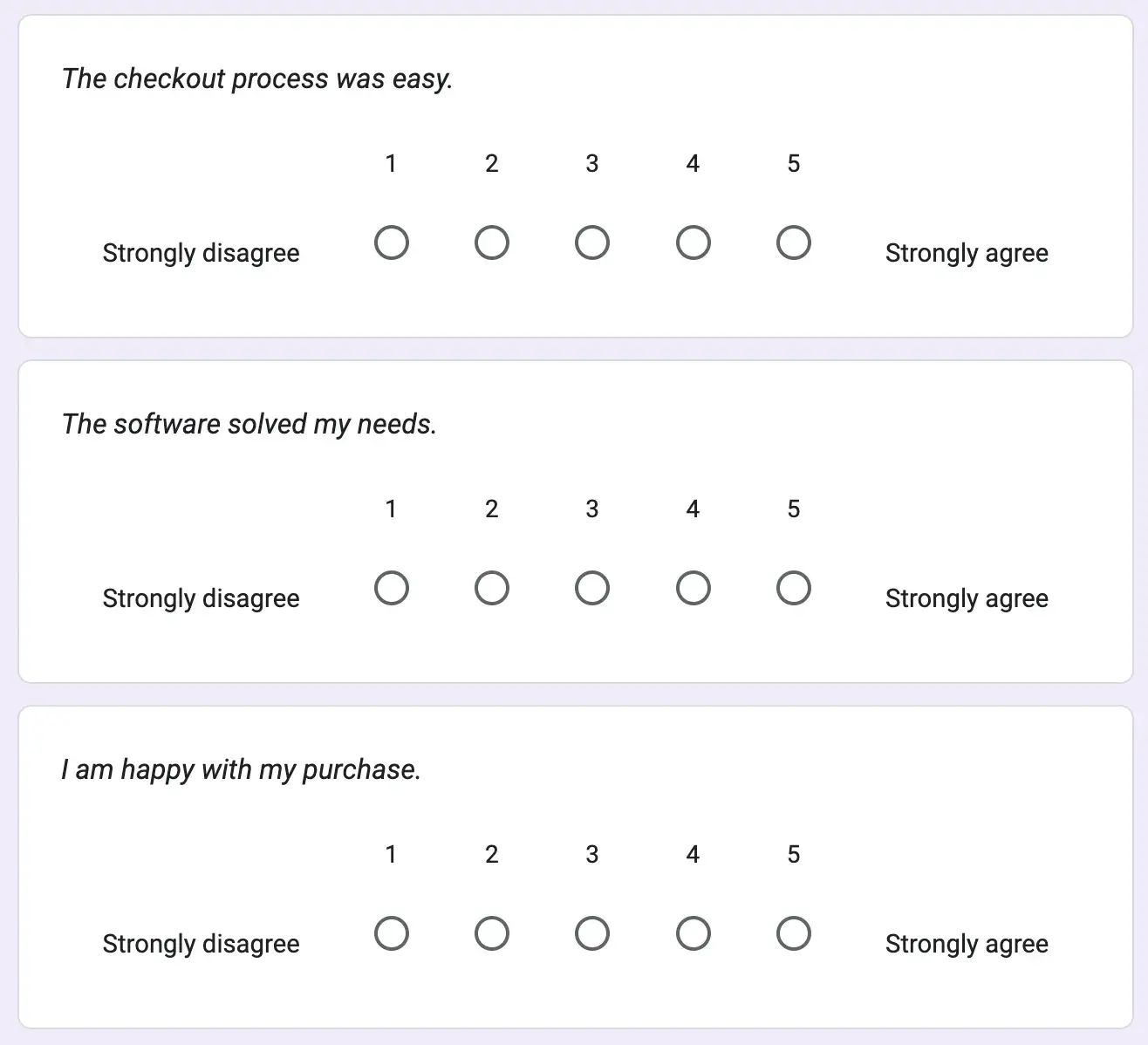
With 1,000 participants, I can organize their responses into the following table and calculate the mode and median.
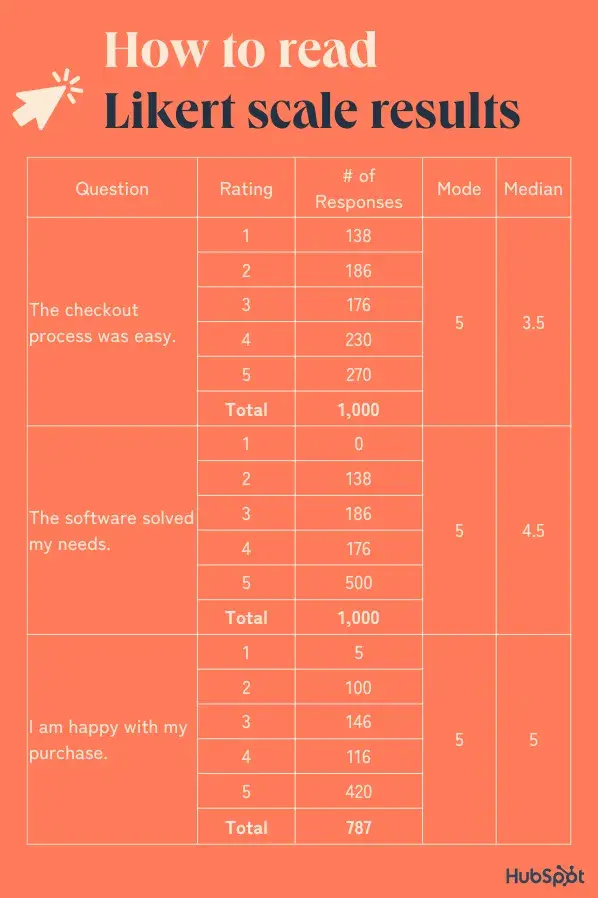
These stats reveal overall positive satisfaction ratings from my customers. I find visualizing the results as a bar graph is super helpful.
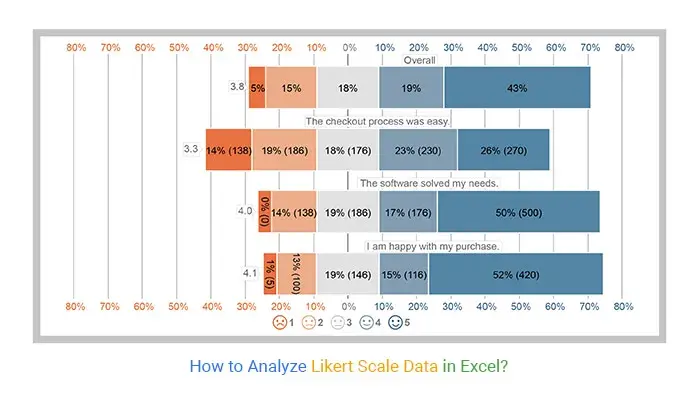
The “Overall” rating at the top uses the mean from all the questions to display overall sentiment. For instance, to calculate how many “Strongly agree” responses I received from the whole survey, I would perform the following calculation:
(270 + 500 + 420) / (1,000 + 1,000 + 787) =
1,190 / 2,787 = 0.426 = 43%
This average, along with 19% of customers who responded “Agree,” means that the majority of my customers are satisfied with their experience of my company and product.
However, I can see that the weakest area is the checkout process. I received the fewest 5s and the most 1s, so I should focus on improving the checkout experience for my clients.
Pro tip: For more advanced analytics, you can use cross-tabulation, t-tests, or ANOVA. Check out this article for more details.
Tips for Writing Likert Scale Survey Questions
1. Write clear questions or statements.
When crafting your Likert scale survey, be sure to write clearly. Your questions should be unbiased, not loaded, and phrased neutrally. You can skew your results if you don’t write clear, concise, and neutral questions.
2. Only ask one thing at a time.
For each survey question, make sure you are asking for respondents to share their opinion or feelings on one thing only. If you load the statement with multiple ideas, they will not be able to give a clear response by simply choosing one number on the scale.
3. Use both negative and positive framing.
It’s important to use both negative and positive framing questions in a survey (but avoid double negatives) in order to capture participants’ full perspectives. This is especially helpful if your survey employs multiple statements surrounding a similar idea or topic.
- Positive Example: I think climate change is an important issue we need to be concerned about.
- Negative Example: I am not concerned about my carbon footprint.
4. Use both statements and questions.
Mix up how you present the information you want participants to respond to. Phrasing different questions as a statement or question might elicit different responses, and you can see if the participants are consistent in their views or not.
- Statement Example: I am really satisfied with the help the service rep provided me.
- Question Example: How satisfied are you with the help you received from our service representative?
5. Be sure the response scale is a continuum.
When associating response options with each number, be sure the options are on the same continuum, always ensuring the middle option is neutral. Also, make sure that two of your options don’t amount to the same meaning, even if phrased differently. It will confuse participants and muddle your data.
Likert Scale Templates
Now that you understand how Likert scales work, I’ll share some templates with you to get started on your next survey.
1. SurveyMonkey
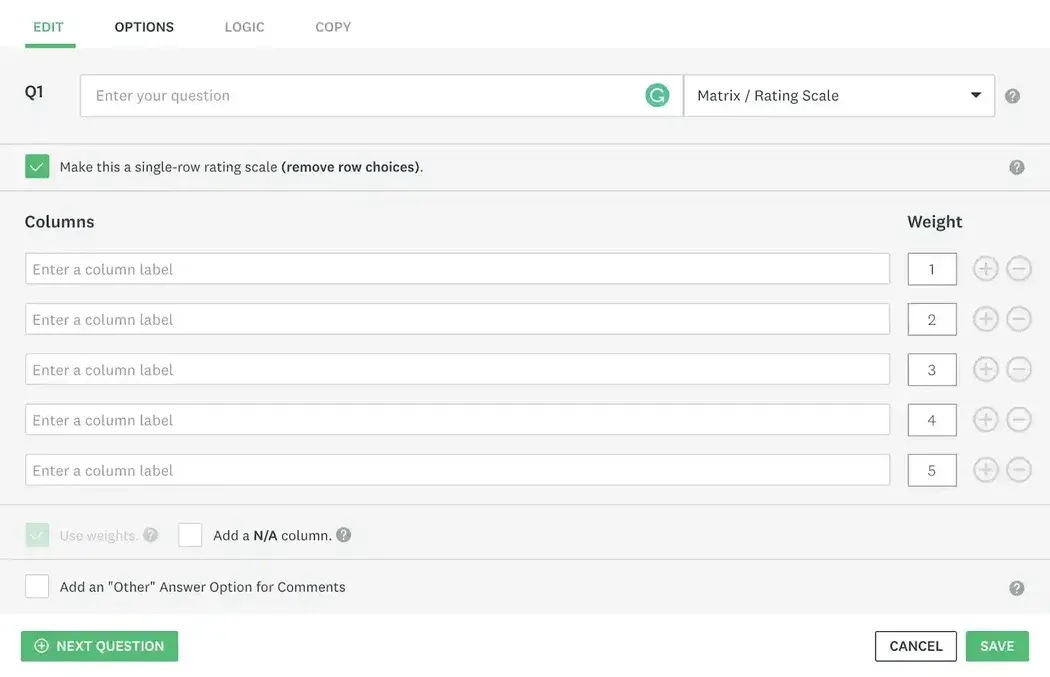
On SurveyMonkey, you can easily create a Likert scale using the template above. Simply type in your question, select “Matrix / Rating Scale,” and check the box next to “Make this a single-row rating scale (remove row choices).”
The template will automatically give you five response options, but you can always add or delete them depending on how many options you'd like to have. Then, fill in a label for each column, such as “never,” “rarely,” “occasionally,” “frequently,” and “always.” When you hit “Save,” it will show you a preview of how the question will look.
Pro tip: Since it is a software devoted to creating surveys, Survey Monkey is a great option for businesses that survey customers often or that have a large customer base.
2. Google Forms

Google Forms is another simple tool you can use to build questionnaires, including Likert scale questions. First, fill in a question or overarching statement, such as “Evaluate our brand in terms of the following statements.” Then, select “Multiple choice grid” as the type of question. I think multiple choice grids are perfect if you'd like to ask several questions or list statements that all fall under one type of Likert scale question.
Clicking this will lead you to an option to create “Rows and Columns.” Each row should be filled in with a statement or question you'd like to ask participants, such as “I would recommend this brand to others.” Each column label should be filled with a point on your scale, like “strongly agree.”
Once you've finished, your question will look something like this:
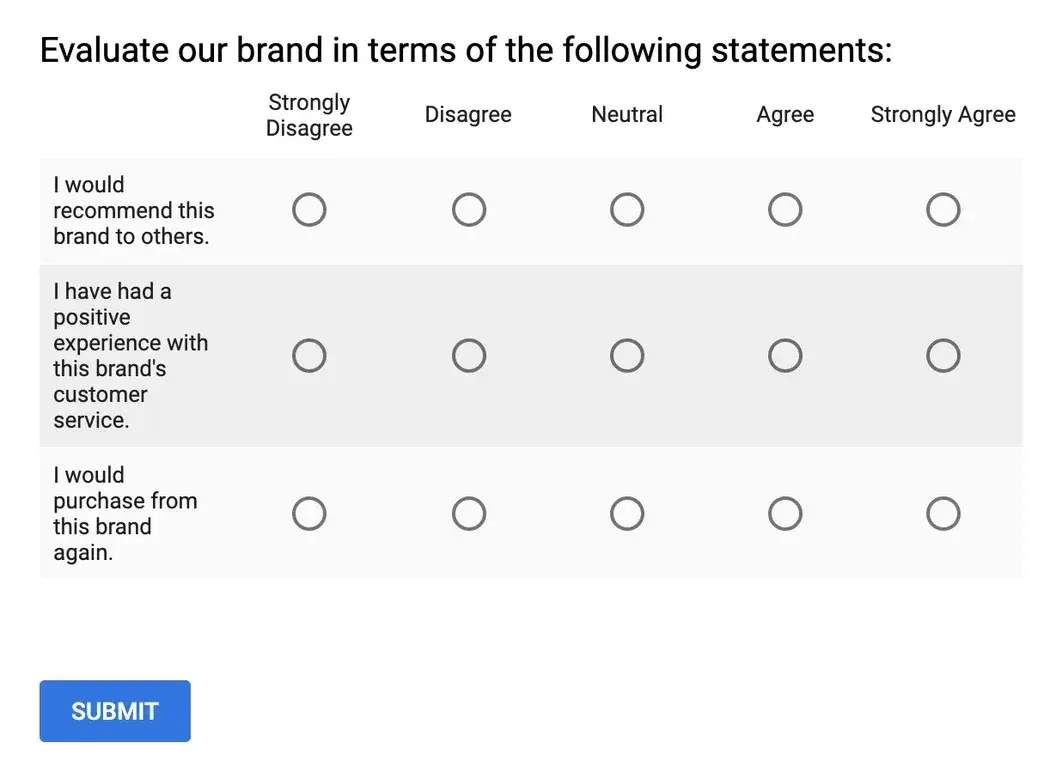
Pro tip: Check out these free survey tools so you can try creating your own.
3. Self-Made
Finally, you can also create your questionnaire the old-fashioned way on a document tool, such as Microsoft Word, Pages, or Google Docs. This is a good option when sending out internal questionnaires or printing out and mailing them.
You can type up your questions and have users complete the survey on the same document, like in the template below.
I am treated fairly by my manager.
___ Strongly Disagree
___ Disagree
___ Neutral
___ Agree
___ Strongly Agree
If receiving the questionnaire digitally, participants can easily place a checkmark or “X” on the option they most agree with. If receiving the questionnaire via hard copy, they can fill it out by hand.
Pro tip: For more ways to gather customer feedback, read about different survey questions.
Ready to Build Your Next Customer Survey?
My biggest takeaway is that Likert scale questions are really valuable for assessing sentiment and opinions because they give respondents a range of choices while automatically quantifying their feedback, making it simple for the surveyors to read and interpret the results. Surveyors get more granular data while participants don’t need to spend lots of time answering open-ended questions. A win-win, in my opinion.
So what are you waiting for? With these tips and insights, incorporate Likert scale questions into your next customer survey. And for more inspiration, check out HubSpot’s customer satisfaction survey templates below.
Editor's note: This post was originally published in August 2019 and has been updated for comprehensiveness.
Survey Creation
.png?width=112&height=112&name=Image%20Hackathon%20%E2%80%93%20Vertical%20(85).png)

.png)
![16 best free online survey makers and tools [+ recommendations]](https://53.fs1.hubspotusercontent-na1.net/hubfs/53/free-online-survey-maker-1-20251028-2654831.webp)


![How to conduct survey analysis like a data pro [all my tips + secrets]](https://53.fs1.hubspotusercontent-na1.net/hubfs/53/survey-results-1-20241031-6355381.webp)
![Leading questions: What they are & why they matter [+ Examples]](https://53.fs1.hubspotusercontent-na1.net/hubfs/53/leading-questions-hero.webp)
![How long should a survey be? The ideal survey length [New data]](https://53.fs1.hubspotusercontent-na1.net/hubfs/53/how%20long%20should%20a%20survey%20be_featured.png)



